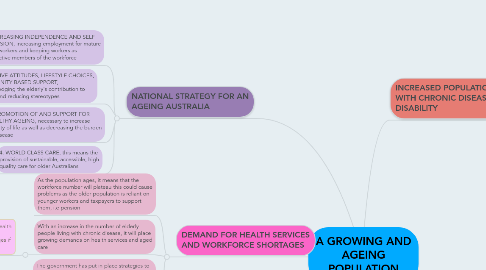
1. AVAILABILITY OF CARERS AND VOLUNTEERS
1.1. The majority of home and community-based services are provided through the Home and Community Care (HACC), they provide a number of services that support the elderly in their own residence, such as home maintenance, transport and shopping assistance etc
1.2. Individuals over the age of 55 contribute to $75 BILLION of unpaid work. EG include, SES, Surf Clubs, Driving elderly, Meals on Wheels, Vinnies, Community Events
1.3. As Australia's population ages, the number of people requiring informal care at home and in their community is expected to increase, whilst the number of carers is expected to decline. The number of carers expecting to decline is due to the fact that they are ageing themselves
1.4. Carers are important for providing support and assistance to the elderly to enable the performance of daily tasks
1.5. The number of people needing aged care is projected to rise by 160%
1.5.1. In 2001, there were 57 primary carers for every 100 people over 65 years, by 2031, the ratio is projected to drop to only 35 carers for every 100 people over the age of 65 needing care
1.6. It is projected that there will be little growth in the number of aged carers, compared to the rise in support needed
1.6.1. This may be due to the lack of desire for the job, in order to overcome this, pay needs to increase and the job needs to be more appealing, in order to attract more employees
2. DEMAND FOR HEALTH SERVICES AND WORKFORCE SHORTAGES
2.1. As the population ages, it means that the workforce number will plateau this could cause problems as the older population is reliant on younger workers and taxpayers to support them, i.e pension
2.2. With an increase in the number of elderly people living with chronic disease, it will place growing demands on health services and aged care
2.2.1. There will need to be, more funding for health care facilities, more training of aged care facilitator and there will be labour shortages if older people are unable to work
2.3. The government has put in place strategies to ensure the cost of aged care is shared by the whole population. There is now a means tested aged pension, compulsory superannuation, that employers must pay and tax incentives for private superannuation/savings plan
3. NATIONAL STRATEGY FOR AN AGEING AUSTRALIA
3.1. 1. INCREASING INDEPENDENCE AND SELF PROVISION, increasing employment for mature aged workers and keeping workers as productive members of the workforce
3.2. 2. POSITIVE ATTITUDES, LIFESTYLE CHOICES, COMMUNITY BASED SUPPORT, acknowledging the elderly's contribution to society and reducing stereotypes
3.3. 3. PROMOTION OF AND SUPPORT FOR HEALTHY AGEING, necessary to increase quality of life as well as decreasing the burden of disease
3.4. 4. WORLD CLASS CARE, this means the provision of sustainable, accessible, high quality care for older Australians
4. HEALTHY AGEING
4.1. high rates of chronic disease and disability in aged care population, can be significantly decreased and prevented through active and healthy living
4.2. the global aged population is expected to reach 20% of the entire population by 2050
4.3. healthy ageing has become important for Australia and the rest of the world
4.4. it begins in younger years, not just the elderly. Most chronic diseases can be attributed to poor diet and health choices as a younger individual
4.5. having older people living longer, benefits society as they have a wealth of knowledge and experiences that society can benefit from. It also means that their skills and knowledge can be utilised longer and passed down to younger generations
4.5.1. FOR EXAMPLE, community benefits include, reduced burden of disease and illness in the community, less financial pressure on the health care system, fewer people require aged care facilities and palliative care
4.6. Healthy ageing benefits the individual as well as the community
4.6.1. FOR EXAMPLE, individual benefits include, improved quality of life with fewer years lived in illness or disability, decreased health-care costs and more opportunities for social interaction
